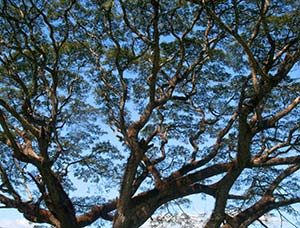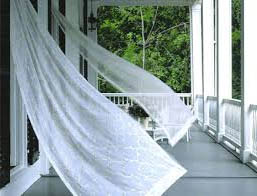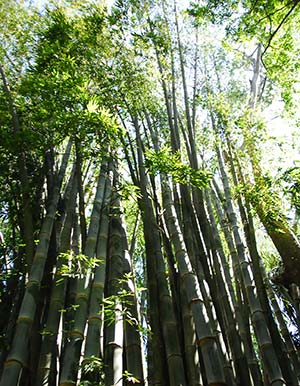 Trees seem like they must be nature’s greatest gift when it comes to green building in the tropics, but when I compiled a list of the positives and negatives, there were actually more negatives, as shown below. However, in the bigger picture of trying to create a beautiful dream eco home, the positives still far outweigh the negatives.
Trees seem like they must be nature’s greatest gift when it comes to green building in the tropics, but when I compiled a list of the positives and negatives, there were actually more negatives, as shown below. However, in the bigger picture of trying to create a beautiful dream eco home, the positives still far outweigh the negatives.
In general, beautiful jungle trees are for most people one of the principal attractions of the tropics, and many people fantasize about living in one, Tarzan style, when they first come to Costa Rica. But most will settle for living among them.
From a green-building point of view, trees are a great boon for their shade, beauty, and as a sustainable construction material, but they can also be hazardous to your house, so I thought it was important to discuss this here so you can take precautions and be aware of the possible consequences of living among different types of trees.
Tree Positives:
Shade
The most obvious benefit of a tree is its ability to shade your house, since by far the majority of heat energy affecting your home will be from direct sunlight. When it comes to shade, the best house site would have a large hardwood tree to the south, with branches overhanging it like a giant umbrella. Of course, we’re ignoring the dangers of the tree falling on your house, the problem of leaves raining down and clogging your gutters, etc (see below). The average position of the sun in Costa Rica is ten degrees to the south, and so a tree on the south side will be best placed to provide maximum coverage.
The late afternoon sun is also very intense in Costa Rica, since your house will have been heating up all day, and then as the sun goes down, it will start to really affect the west side, so having a tree on the west would be the second best position, and because the sun will be at an angle, it won’t need to be overhanging.
Beauty
A large beautiful tree next to a house will make it so much more attractive as well as providing shade. A beautiful house with “curb appeal” is a better investment, and few people buying in Costa Rica imagine a house without any trees around. So whether it’s fruit trees, hardwood trees, or palm trees, almost any trees will make your home more beautiful and thus more valuable.
Wildlife
Having a large tree next to your house is also a great way to see lots of wildlife, especially if that tree has its canopy connected to a larger forest nearby so that arboreal animals such as howler monkeys, tree opossums, sloths, or kinkajous can easily climb into your view without walking on the ground where they feel unsafe. Many house sites have a “view” side which faces the ocean or beautiful mountains, and the owners make the mistake of ignoring the backside. While an ocean view is fantastic, so it a view of a rainforest! This is where you’re going to see a lot of wildlife, and it’s often cooler on the jungle-side of your home. So, be aware that most homesites have more than one beautiful view.
Sustainable Material
Wood is one of the greatest building materials, so consider planting a few, with the idea of harvesting them in the future. Your investment will take 25+ years to mature, since usually you can only use the dark heart-wood of the trees for building if you want to keep the bugs out of it without poison. But meanwhile, you’ve got shade and beauty. You may find it difficult to cut down a big beautiful tree you’ve become accustomed to seeing on your property, but you can cross that bridge when you get to it.
Tree Negatives:
Will your shade tree fall on your house? So you build your dream house underneath a huge old tree and then a few years later, a big storm comes and the thing falls on your house, destroying it. Some trees are so big that even just a large branch can do a lot of damage. So how do you get shade while protecting your house from trees falling on it at the same time? The easiest thing to do is to make sure your shade trees are hardwood trees, which have deep roots and are not likely to blow over. You can then trim the tree so that it’s heavier on the other side, so that if it does fall, it’s more likely to fall away from your home. More about this in a separate article: Tree Placement for Eco Homes
Roots vs foundation
All trees have roots, and some, such as the banyan/fig/higueron trees, have roots that are very invasive and penetrating. Almost any tree placed too close to your home will create a root structure that will damage your house’s foundation. Some green-building score calculators, such as the LEEDS system, give you points for keeping all vegetation a certain minimum distance away from the house. A way around this is to build the house on heavy concrete blocks/risers, so that any tree roots will simply grow around them, rather than trying to penetrate them. How close to the house is too close? The closer it is, the better shade it will provide and if it does fall, it’s not going to hit your house very hard if it’s right next to it. However, if it’s too close, then it can sway in the wind and break your roof during storms even if it doesn’t lose a branch.
Snakes
Most people seem to be afraid of snakes and some people are absolutely terrified of them, whether they’re venemous or not. I love snakes, and my current home is built right next to a large higueron “banyan” tree. Although I’ve never seen a snake in it, these types of trees are famous for being favorite places for snakes and other wildlife to hide in, because of their intricate and convoluted trunk and root systems provide dozens or hundreds of small crevices and caves for critters to hide in. A large banyan tree can be an eco-system of its own, and where there’s small critters, there’s the snakes who eat them. So, if you’re terrified of snakes, you probably don’t want one of these types of trees next to your house.
Termites
Certain types of trees are known for attracting termites. For example, the carao tree, a close relative of the carob tree, is a soft-wood tree that is often infested with termites, because the branches of it seem to have a lot of dead wood. So, if you have wood in your house’s structure, you probably don’t want to have trees such as this too close, because this termite food source will lead to more problems for you. Termites are nearly impossible to get out of your house through “organic” methods, so taking good steps initially is important. More on termites here.
Falling Leaves
Leaves from your beautiful tree will rain down nearly day and night onto your roof and into your pool. If they pile up too much on your roof, then water can begin to leak between the tiles. If you have a gutter system, the leaves will undoubtedly find a way to clog it up, because even if you have extra-wide vertical gutter tubes, small sticks will also fall down and will assemble themselves into small nets that become dams that block the water. This leads to wood rot, leaking, and mosquito problems. Leaves will also fall into your swimming pool, where they will rot and require extra cleaning, and they’ll block your filter, which can burn out your pump, costing you $400 or so every time it happens. If you want a tree overhanging your house, you should design it so it doesn’t have gutters, and the roof should be fairly steep. Water and leaves will run off, and you’ll control the water on the ground with gravel or other techniques so it runs where you want it to go. For your pool…. keep it away from trees and check it often when it’s windy. Lots of leaves will blow into your pool, clogging it up within an hour sometimes.
Lack of summertime shade
Some people are in for a shock when they purchase a home that’s in the shade during rainy season, only to discover that when you need it the most, in dry season, that shade tree loses all its leaves! This is often the case in beach houses such as in Santa Teresa, where there are a lot of pochote trees.
Trees keep from having their leaves burned by the sun by constantly evaporating water to keep them cool. Once their root systems have sucked out all of the available water, many trees in Costa Rica will go into dry-season hibernation. Trees that have leaves all year usually have deeper root systems that reach more water.
You can help this by watering your trees roots, so it will hold onto its leaves longer. You can also plant trees that have leaves all year, such as palm trees, beach almond, mountain almond, and higueron/fig/banyan trees. Most local hardwoods lose their leaves for at least half of dry season, and almost all softwood trees have shallower root system and thus are the first to drop their foliage.
Forest Fires
In drier parts of Costa Rica, the entire jungle appears to turn into a huge pile of kindling, and it seems almost a miracle that there aren’t more forest fires here. I really wouldn’t recommend having trees overhanging your house if they’re connected to the jungle and are the type that tend to lose their leaves. If you do, you should have a chainsaw ready and plan to run out and cut down that tree in the unlikely even of a forest fire, or else it’s going to destroy your house.
Types of Trees
Fruit Trees
One of the best parts about tropical living is being able to have fruit trees around your house so you can get them for free and super fresh. Most are seasonal, but a few, such as coconuts, bananas, and plantains, produce food for you all year. Some types, such as mangoes and water apples (manzana de agua) can produce so much fruit that you can’t possibly eat it all, and it can become a nuisance, with hundreds of fruits rotting on the ground and creating lots of flies.
Limes, lemons, oranges, and grapefruit are great tree sto have here. They are super-healthy and incredibly tasty. Limes and grapefruits, despite being acidic by nature, are actually “alkaline-forming” and are thus very healthy. Adding a bit of fresh lemon to your water is a great way to help neutralize the acid-forming foods you eat. More: 16 Health Benefits of Lemons
Palm Trees
Palms don’t need a lot of water, and the best type of palm is the coconut palm, because they give you coconuts. Coconut water is one of the healthiest things you can ever drink. The negative side of coconuts, besides them falling on your head or breaking your car’s windshield, is that if you leave them around during the rainy season, they will collect water and make perfect little breeding pools for mosquitoes. So, you should chop them up with a machete and let the husks compost.
Softwood Trees
Possibly the best type of soft wood tree is the Ylang Ylang, which has the most beautiful fragrant smell from its yellow/green flowers around dusk. It also has green berries that are a favorite of toucans, kinkajous, and other exotic birds and animals. If you have them on your property, wild animals will discover them and use them as a feeder, since the Ylang Ylang tree has its berries all year in both rainy and dry seasons. So, I highly recommend you plant a few of them on your property, preferably close enough to the jungle so that animals can reach them without climbing onto the ground. Many ylang ylangs will also keep their leaves all through the dry season if you give them water. However, they’re not much good for shade, because they’re shaped like a Christmas-tree.
Hardwood Trees
Hardwood grow slowly but are what we need to rebuild the jungle. Most of the hardwood species have already been cut down for lumber, and it will take around 200+ years to build back up to a real primary forest, which is mostly full of mature hardwood trees. Since it takes so long, start planting now!
 I have titled this website “Airflow and Shade” because I personally consider them to be the two most important factors for tropical green building.
I have titled this website “Airflow and Shade” because I personally consider them to be the two most important factors for tropical green building.